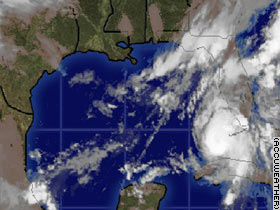 |
|
| Satellite photo shows Hurricane Charley's location Friday morning. |
NEW YORK (CNN/Money) -
While Hurricane Charley hit a much less populated portion of Florida Friday than earlier expected, it hit with such greater force that it was expected to still be the second most expensive storm in U.S. history.
The storm made landfall just before 4 p.m. Friday at North Captiva Island near Fort Myers in Southwest Florida. (Click here for CNN.com's Hurricane Charley coverage.)
Insurance industry loss forecasters had earlier feared a direct hit on the far more densely populated and developed Tampa-St. Petersburg area, which they said would have meant insured losses in the $10 billion range.
But one forecaster said that loss forecast might still end up being accurate, despite the much different storm path.
"The insured exposure, the property value, (of the area where the storm hit) is about one-fifth what it is in Tampa-St. Petersburg, but the hurricane made landfall at much higher level of intensity than expected," said Kyle Beatty, meteorologist for Risk Management Solutions, a provider of catastrophe risk management services for the insurance industry.
"What we thought might be a low category 3 hurricane made landfall as moderate category 4 hurricane."
The latest forecasts called for Charley to retain hurricane force winds as it made its way across the state, passing near heavily populated Orlando, before exiting into the Atlantic Ocean.
Beatty said this path is almost identical to an unnamed 1944 hurricane. He said the firm's modeling of that hurricane, using today's property value and insurance levels, put the insured losses at $10 billion.

That would be second only to 1992's Hurricane Andrew, which hit Southeast Florida near Homestead in the Miami area, as the nation's most expensive storm. Andrew caused an inflation-adjusted $20 billion in damage. Charley could be the most expensive natural disaster since the Northridge, Calif., earthquake of 1994, which did an inflation-adjusted $15 billion in damage.
One of the things that made Andrew so expensive is that after it crossed Florida, it reconstituted itself in the Gulf of Mexico before slamming into Louisiana and Mississippi as a hurricane once again. There is a risk that Charley could do the same, picking up strength in the Atlantic before hitting the eastern seaboard.
The RMS loss estimate is primarily based on expected Florida losses caused by Charley. Friday evening, Charley was forecast to make land a second time Saturday evening near the South Carolina-North Carolina border, but downgraded to a less severe tropical storm at that point.
Beatty said forecasters would be watching carefully over the next 24 hours to make sure Charley doesn't pack a second costly punch.
"Right now, when we look at insurance losses in the Carolinas, they're not substantial," he said.
But one of the great risks for residents of the Carolinas is from flooding, which isn't covered by private insurance, only Federal Flood Insurance, and therefore not covered in the loss estimates from firms such as RMS.
The Carolinas have been hit by heavy rains from the remains of Hurricane Bonnie, which came ashore at the Florida panhandle as a tropical storm Thursday. The heavy rains could fill rivers and streams and saturate the ground, raising the flood threat posed by Charley when it comes ashore there, even if it is only a tropical storm at that point, said Tom Downs, meteorologist at Weather 2000.
"It's like a sponge that's already filled with water, it won't be able to take in any more water," he said.
As for the damages from Charley's high winds Friday, among the publicly-traded insurers most exposed to losses in the region are Allstate Corp. (ALL: Research, Estimates) and RenaissanceRe Ltd (RNR: Research, Estimates) , according to a research report by Prudential analyst Jay Gelb.
Some companies that are more moderately exposed are: XL Capital Ltd (XL: Research, Estimates)., ACE Ltd., St Paul Travelers Companies Inc. (STA: Research, Estimates), Chubb Corp. (CB: Research, Estimates), Progressive Corp (PGR: Research, Estimates), Hartford Financial Services Group Inc. (HIG: Research, Estimates), Safeco Corp. (SAFC: Research, Estimates) and Dow Jones industrial average component American International Group Inc. (AIG: Research, Estimates)
Among the assets at risk from the storm is a significant part of Florida's citrus crop. While this year's harvest was recently completed, limiting the near-term effects on the price of oranges and orange juice, next year's crops could be affected if the storm hits groves near Florida's Gulf Coast, said Casey Pace of the Florida Citrus Mutual, the growers' association.
Pace said that this could be one of the worst storms for citrus farmers, because in the past they were located far more inland. A series of hard freezes about 10 years ago prompted many growers to move south to new groves nearer to the Gulf Coast.
"We don't have that much experience with Gulf hurricanes," she said.
But with the course of the hurricane still uncertain, orange juice futures were trading only slightly higher on the New York Board of Trade Friday afternoon.
Big retailers such as Home Depot Inc. (HD: Research, Estimates) and Lowe's Cos. (LOW: Research, Estimates) reported strong sales of wood, batteries, bottled water and cleanup materials in Florida as people boarded up their homes and prepared for the hurricane and its aftermath.
"In the last 96 hours, we have shipped 440,000 sheets of plywood into the west coast of Florida, 30,000 generators, 1.2 million batteries and 150 truckloads of flashlights," said Home Depot spokesman Don Harrison. "Those are some of the items that are just flying off the shelves right now."
He also cited a sharp rise in sales of cleaning supplies such as materials that repel water, mops, buckets, brooms, chainsaws, gas cans, rakes, shovels and rubber gloves.
"The flip side of hurricane preparation is hurricane cleanup," Harrison said.

-- Reuters contributed to this report.
|

